Peaches can be sold fresh or juiced. This publication will set guidelines for and present a case study of the juicing process using 'UFSun' peaches.
Introduction
Since the beginning of the stone fruit breeding program in 1952, UF/IFAS researchers have worked to breed peach cultivars that will grow well in subtropical climates such as Florida’s (Sarkhosh, Olmstead, Chaparro, et al. 2019). Commercial-quality peaches are currently harvested earlier in Florida than in all other parts of the United States (Sarkhosh, Olmstead, Chaparro, et al. 2019; Sarkhosh, Olmstead, Williamson, et al. 2019; Chang et al. 2019). Amongst the most successfully bred is ‘UFSun’, a high-yield, yet small-sized cultivar (Rumble, Harders, and Stofer 2021). Fresh market sales consider large fruit (2.5 inches in diameter) to be high quality, while smaller fruit is not accepted by retailers (Change et al. 2019). Due to this limitation, ‘UFSun’ can be less competitive in a fresh market setting when compared to larger peaches that are harvested from other states.
Outside of fresh market and grocery store sales, peaches are also sold at farmer’s markets, U-Pick operations, growing cooperatives, and roadside stands (Sarkhosh, Olmstead, Williamson, et al. 2019; Ferguson et al. 2008). Current market research shows that the consumption of fresh produce will continue to exhibit annual growth through 2021— indicating consumer interest in purchasing more fresh, natural products on the market (Freedonia Group 2017). Additional opportunities for revenue growth are possible through further value-added processing, specifically pressing peaches for juice that can be used in beverages such as juice, cider, beer, wine, and kombucha. Assessment of Florida consumer research behaviors indicated that “a large number of consumers would purchase food with the Fresh from Florida logo,” which includes foods that have been grown, raised, harvested, or produced in Florida (Rumble and Roper 2017).
This publication serves as a guide for stone fruit growers assessing additional revenue sources and those considering the adoption of peach growing and processing operations. It will discuss juicing and quality parameters of ‘UFSun’ peaches, as well as tree care, postharvest handling, and economic considerations.
‘UFSun’ Peaches
‘UFSun’ is a non-melting cultivar, meaning that it can be harvested, transported, and processed without loss of fruit integrity (Iezzoni 2019). The cultivar is also high yield and horticulturally mature two months prior to the rest of the United States peach crop. It is estimated that ‘UFSun’ trees yield approximately 14,500 lb/acre in north central Florida. However, as previously explained, ‘UFSun’ fruit is smaller in size than what is typically accepted in the fresh market. This is partially due to a shorter fruit development period in Florida (Sarkhosh, Olmstead, Chaparro, et al. 2019; Sarkhosh, Olmstead, Williamson, et al. 2019; Chang et al. 2019; Rumble, Harders, and Stofer 2021; Ferguson et al. 2008), where there are fewer light-hours and higher heat indexes than temperate growing conditions seen in Georgia and North and South Carolina. Additionally, optimum cultural practices are necessary to ensure high quality fruit.
Tree Care
One way to encourage larger fruit growth of ‘UFSun’ peaches is by thinning fruit before their pits harden. Pit hardening occurs when the fruit reaches the size of a quarter coin in diameter—typically 40 days after flowering for ‘UFSun’ (Chang et al. 2019). Trees are thinned by reducing the number of fruit on each branch until there are at least 6 inches between each remaining fruit (Chang et al. 2019). This strategic spacing helps to decrease competition for sugars and other key nutrients, promoting higher quality fruit. Although thinning provides larger fruit, it also reduces the overall yield of fruit mass from the tree, and the process of thinning costs between $1,500 and $2,000 per acre (Ferguson et al. 2008). Hand thinning and manual pruning are currently the largest expenses in Florida peach production (Sarkhosh, Olmstead, Williamson, et al. 2019).
Several environmental factors can affect fruit yield from a tree, including tree age, size, and the degree of fruit thinning (Ferguson et al. 2008). A five-year-old thinned ‘UFSun’ tree has been shown to produce 70 lb per tree in north-central Florida according to Ali Sarkhosh and research performed in Citra, FL—the location of an experimental peach orchard located at UF/IFAS Plant Science Research and Education Unit (PSREU). Healthy unthinned trees will produce approximately two to three times the fruit mass of thinned trees (Ali Sarkhosh, unpublished interview, 2018), although fruit from the unthinned trees will be smaller (Chang et al. 2019). Additionally, if trees are not thinned, the smaller fruit will grow closer together, often harming the tree long-term by overloading, weighing down, and breaking tree branches (Chang et al. 2019). Figure 1 compares the fruit load of a thinned and an unthinned tree. More information on thinning can be found in Ask IFAS publication #HS1324, “Thinning Florida Peaches for Larger Fruit.”
A study of the effect of fruit thinning on fruit size and weight was conducted on cultivar ‘UFSun’ at the UF/IFAS in 2018. Results showed that thinning increased the weight of tree-ripened fruit by 45% and the total diameter by 14% (Chang et al. 2019), demonstrating that thinning is critical in enhancing the size of fruit. With fruit harvested from the same trees described in this study, an additional 2018 study analyzed juice pressed from thinned and unthinned tree fruit. UF/IFAS researchers found that there was a significant difference (p < 0.05) between the juice pressed from each type of peach in terms of sugar content. As detailed in the section Measuring Juice Quality, the average sugar content of thinned and unthinned juices were 10.3 °Brix and 9.7 °Brix, respectively. According to the FDA, typical concentrations of 100% peach juice are 10.5 °Brix, but all “juices directly expressed from a fruit…shall be considered to be 100% juice” (FDA 2019).
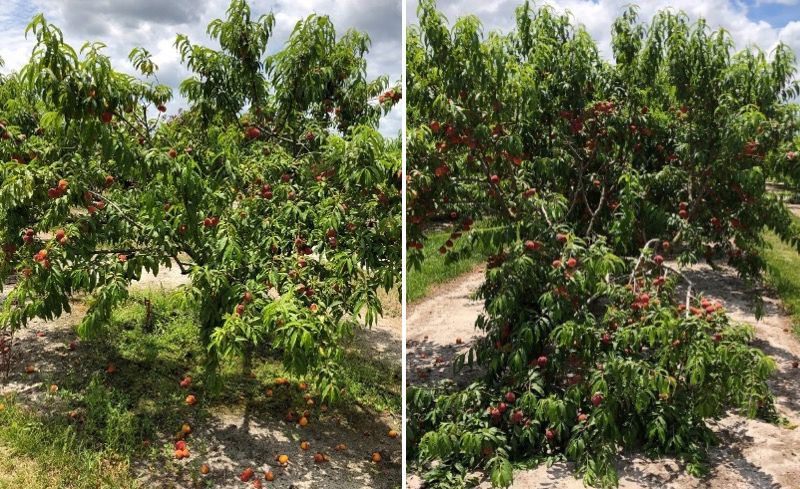
Credit: Ali Sarkhosh, UF/IFAS
Postharvest Handling and Storage
Time of harvest is important for peaches because they are a climacteric fruit (Sarkhosh, Olmstead, Chaparro, et al. 2019; Crisosto and Costa 2008). Climacteric fruits do not increase in sugar content once they are removed from the tree because they store very little starch, although they do soften with aging (Sarkhosh, Olmstead, Chaparro, et al. 2019). Peaches contain the same amount of sugar when they are picked and throughout fruit aging (Sarkhosh, Olmstead, Chaparro, et al. 2019; Ferguson et al. 2008). The longer a peach is left on a tree to ripen, the more sugar it will contain. This could influence optimum harvest maturity when peaches are intended for juicing, as high-sugar peaches may be preferred. However, even when picked and handled perfectly, peaches are quite perishable and susceptible to mold compared to most fruits (Crisosto and Valero 2008). Peaches also deteriorate rapidly at ambient temperatures, therefore requiring cold storage to slow down aging (Crisosto and Costa 2008; Lurie and Crisosto 2005). Literature suggests that the optimum storage conditions for peaches are in a cold storage room between –1.1°C and –4.4°C (30°F to 40°F) in temperature (Crisosto and Valero 2008) with 90% to 95% humidity (Kader 2013). Fruit preserved under these conditions will retain quality for up to a week. Fruit degrades quickly at ambient temperatures and experiences chilling injury at excessively low temperatures. Chilling injury decreases the textural quality and juice content of fruit (Lurie and Crisosto 2005). All peaches used within this study were juiced within one week of harvest. A 2018 UF/IFAS case-study on small-scale juicing operations that used fruit held in a cold room at 4.4°C (40°F) with 80% to 90% humidity (Curtis 2019) is detailed in the next section.
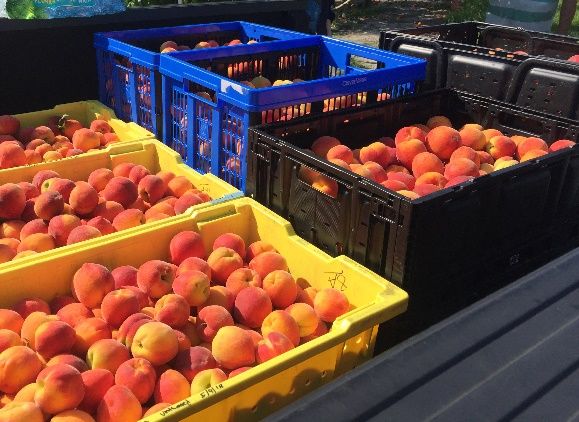
Credit: Savanna J. Curtis, former graduate student, UF/IFAS
Case Study: Juicing ‘UFSun’ Peaches
Peaches are most often processed into a puree as opposed to lower-viscosity juice due to high amounts of pectin and fibers (Bates, Morris, and Crandell 2001). However, Florida peach production focuses on fresh market sale rather than processing fresh peaches into purees and juices. This section represents a guided set of recommendations for performing small-scale juicing operations based on a 2018 UF/IFAS experiment where 2,000 lb of ‘UFSun’ peaches were juiced for use as a brewing additive (Curtis 2019). The outlined yield, quality, and process steps may be useful to anyone interested in processing non-melting flesh peaches, as results obtained from ‘UFSun’ analysis are likely applicable to all non-melting species. Peaches are harvested based on a grading system. Grading refers to the peach selection process when deciding which peaches will be sold on the fresh market. According to a UF/IFAS Extension publication (Ferguson et al. 2008), fruit is graded by size, color, shape, sensory attributes, and the degree of flesh browning. This publication goes on to explain how, while fruit size and color are more highly considered in grading, “fruit with high aroma, moderate acidity, and sweet taste are the most desirable.” Figure 3 displays a process flow diagram that outlines each step of the juicing process as performed in the study: rinsing, sorting, and cutting; heat treatment (blanching); pressing; commercial sterilization; and storage. It is important to note that future results will vary based on fruit ripeness, natural variability, etc.; however, the outlined processing steps and subsequent findings may serve as an example for Florida growers and farmers.
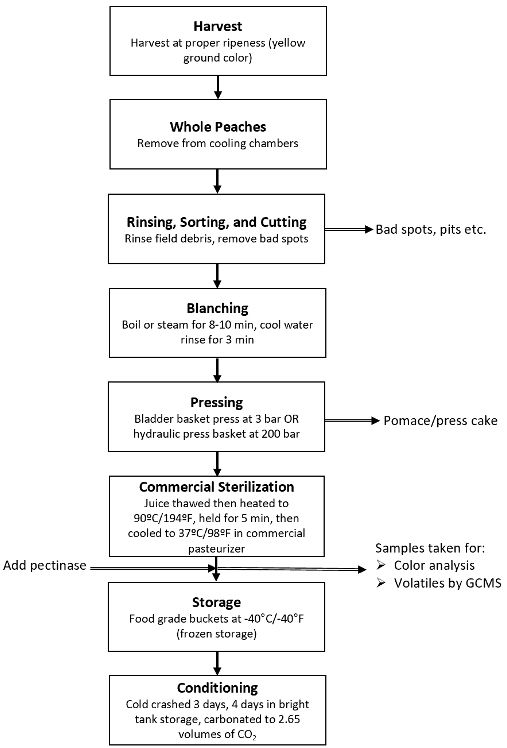
Credit: Savanna J. Curtis, former graduate student, UF/IFAS
Rinsing, Sorting, and Cutting
To remove field debris and insects, peaches were rinsed with tap water. After rinsing, peaches were hand-sorted to separate out leftover debris and cut out bad spots (Figure 4). It is important to remove all brown rot, mold, and insect burrows, as contaminants like these will alter the flavor and quality of the peach juice.

Credit: Savanna J. Curtis, former graduate student, UF/IFAS
Blanching
To avoid oxidation and browning of cut peach flesh and juice, peaches were heat-treated by blanching before they were pressed. Peaches can be blanched in several ways including with steam and boiling water. Peaches were blanched both ways during this case study. For steam blanching, peaches were loaded onto a wire blanching tray into a hooded steam blanching unit, as shown in Figure 5. Steam (110°C/230°F) was flushed over the peaches for eight minutes then rinsed with cold water for three minutes to cool down the peaches. When using boiling water to blanch peaches, fruit was submerged underwater for ten minutes then plunged into an ice bath until they were cool to the touch. The steam and boiling water set-ups used for the UF/IFAS experiment can be seen in Figure 6. Once cooled, the fruit was loaded into a press for juicing.
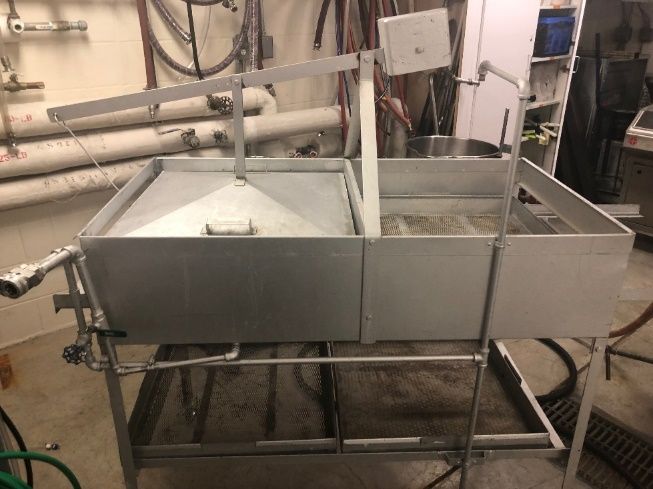
Credit: Savanna J. Curtis, former graduate student, UF/IFAS
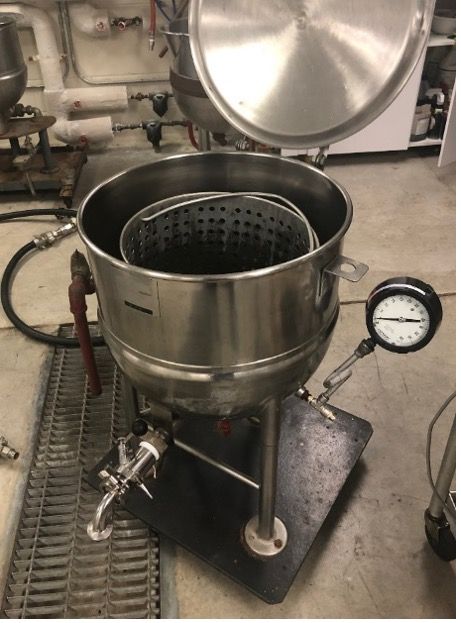
Credit: Savanna J. Curtis, former graduate student, UF/IFAS
Pressing
Peaches were pressed one of two ways in the UF/IFAS case-study: in a bladder basket press (Figure 7) at 3 bar or in a hydraulic basket press (Figure 8) at 200 bar. Juice yields of approximately 50% by weight (i.e., one pound of juice from two pounds of peaches) were attained with the bladder press while the hydraulic press yielded over 60% juice from peach flesh. The yield of juice from fruit flesh is highly dependent on how soft the fruit is after blanching and the amount of pressure being applied to the fruit in the press. A colander can be inserted into the juice reception bucket to capture any pulp or other solid matter that is not part of the juice (Figure 9). From the results gathered, using a hydraulic piston press at higher pressures was more efficient in juice production than a bladder press (240 lb of juice with hydraulic press versus 200 lb with bladder press from 400 lb of fruit).

Credit: Andrew J. MacIntosh, UF/IFAS
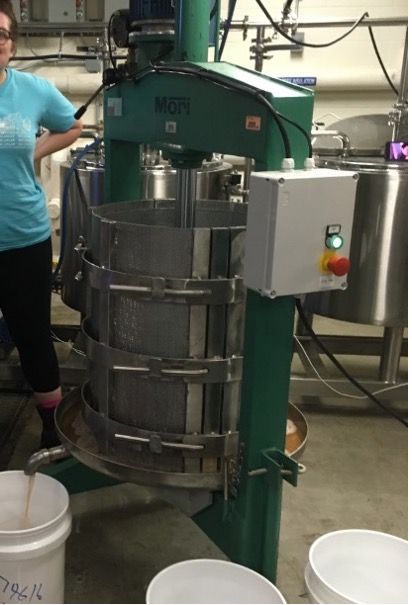
Credit: Andrew J. MacIntosh, UF/IFAS

Credit: Savanna J. Curtis, former graduate student, UF/IFAS
Sterilization and Cooling
After pressing, juice was heated for sanitation (Figure 10). To achieve commercial sterilization, juice was run through a plate heat exchanger to achieve a thermal treatment of 90°C (194°F) for the recommended five minutes, as is conventional for high-temperature, long-time treatment, and then rapidly cooled to below 37°C (98.6°F) (Petruzzi et al. 2017; Oliveira, Pintado, Almeida 2012). Although the peaches were already blanched to inactivate oxidation enzymes and retain the red color of the juice, the sterilization step was necessary to ensure that no pathogens or harmful microorganisms made their way into the juice during pressing. Destroying these organisms before storage is important because it guarantees that no harmful pathogens or spoilage bacteria are able to grow during storage.
Cooled juice was pumped into sanitized food-grade buckets. For quality analysis, samples of the juice were collected after cooling. When buckets were filled, pectinase (pectic enzyme) was added to each bucket per manufacturer instructions to break down any fibers that were present in the juice. Pectic enzyme clarifies the peach juice and improves juice yield by reducing the pulp debris.
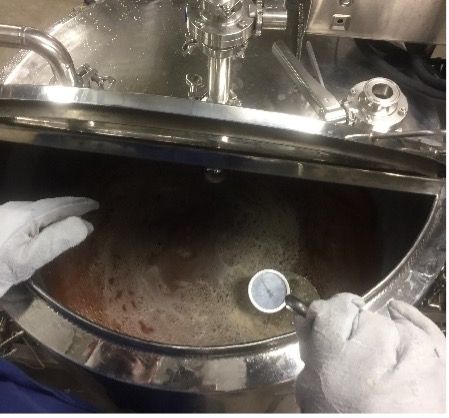
Credit: Savanna J. Curtis, former graduate student, UF/IFAS
Storage
Cooled, sterilized juice can be frozen and stored in hermetically sealed food-grade buckets at –40°C (–40°F) in a food-grade freezer until use. Opening and closing buckets after they have been filled can introduce yeast, bacteria, and mold from the surrounding environment into the juice. Therefore, it is recommended that once sealed, the buckets remain sealed until use.
FDA Processing Regulations
It is important to note that, regardless of the operating capacity of such processes, all Hazard Analysis Critical Control Points (HACCP) recommended for juice by the FDA should be followed. Current Juice HACCP plans reflect changes made with the introduction of the Food Safety Modernization Act (FSMA). An industry guide for such practices can be found at https://www.fda.gov/regulatory-information/search-fda-guidance-documents/guidance-industry-juice-haccp-and-fda-food-safety-modernization-act.
Measuring Juice Quality
When preparing to sell or use peach juice, it is important to know first how much juice is available for use, as well as the sugar content (°brix) and pH of the juice. Particularly for brewing operations, knowing the °brix specifically will provide brewers with an idea of how much juice they will need to add to their product. From a peach grower and processor perspective, knowing the amount of juice yielded from a pressed batch will tell them if they need to allow their fruit to ripen longer on the tree, to lengthen blanching time, to increase the amount of pressure used in their press, and how much juice they have to sell at a given price. °Brix is an indicator of how ripe the fruit was when it was picked as well as the sweetness of the juice they will be able to sell. The pH is an important measurement to determine microbiological stability and safety of the juice since increased pH can allow microbial growth.
Juice Yield
To calculate the amount of juice pressed from peaches, use the equation below:

Credit:
If the peach juice contains pulp, one way to increase juice yield is to add pectic enzyme or pectinase. Pectic enzyme breaks down long fibers that make the juice cloudy and thick, providing a clarified, more desirable juice product (Jayani, Saxena, and Gupta 2005).
Sugar Content
The sugar content (°Brix) of a liquid can be measured several ways, but the simplest method uses a refractometer. A refractometer is an inexpensive handheld device used to measure the amount of soluble solids in a liquid solution containing sugar. On the instrument, solids content is provided in °Brix, which is often assumed to be “% sugar by weight” (e.g., 15 °Brix juice would contain 0.15 lb of sugar per 1.0 lb of juice). Realistically, only approximately 60% of peach soluble solids are typically provided by simple sugars such as sucrose, glucose, and fructose (Abidi 2011). Simple sugars are usable by microorganisms such as yeast during the fermentation process, therefore a yeast-fermentable extract (YFE) analysis was performed in this study to determine the concentration of fermentable sugars in the overall solids profile. Thinned juice had a YFE of 75.0% ± 1.6% while unthinned juice had a YFE of 73.5% ± 2.6%.
Juice Stability
Measuring the pH of a liquid is of paramount importance to safety as it is one of the simplest ways to ensure that harmful microorganisms will not grow in a beverage. In order for a product to be microbially safe, it must be considered a “high-acid” food and have a pH of 4.6 or below according to the U.S. Food and Drug Administration (FDA). An easy way to measure pH is by using test strips that measure pH from at least 0 to 6 in 0.5 pH increments. These strips can be purchased online or at a convenience store, although this is not the most exact method of pH measurement. For a more accurate pH measurement, most analytical laboratories use pH meters. Find more information on purchasing and using pH meters at the following link: https://foodsafety.wisc.edu/assets/pdf_Files/What_is_pH.pdf.
Note that below a pH of 4.6, the juice can still spoil as there are still spoilage microorganisms that can grow and contaminate the product. Therefore, even if the pH is low, it is necessary to refrigerate, pasteurize (Petruzzi et al. 2017), or add preservatives to the product, slowing or stopping the growth of any spoilage microorganisms.
The cleanliness of operating equipment is vital in the production of a safe, saleable product. The FDA reports that cross-contamination of products can occur from the processing equipment and environment. Find more information on pathogen survival and good practices for preparing juices at https://www.fda.gov/food/buy-store-serve-safe-food/what-you-need-know-about-juice-safety, and for pathogen survival in fruits and vegetables, see https://www.fda.gov/food/hazard-analysis-critical-control-point-haccp/potential-infiltration-survival-and-growth-human-pathogens-within-fruits-and-vegetables.
Case Study Results
Figure 11 shows a comparison of juice yields between thinned fruit and unthinned fruit when pressed with a bladder press at 3 bar. Thinned fruit (62%) yielded more juice by weight from flesh than unthinned fruit (50%). This is likely due to the larger size of thinned fruit as they have more flesh in relation to the pit than unthinned fruit. Using a hydraulic basket press at 200 bar produced a higher juice yield from both thinned and unthinned tree-ripened fruit (data not shown) due to applying a higher amount of pressure to the peach flesh overall. Thinned and unthinned fruit produced juice with a significantly different average solids content (p < 0.05) of 10.3 °Brix and 9.7 °Brix, respectively (Figure 12).
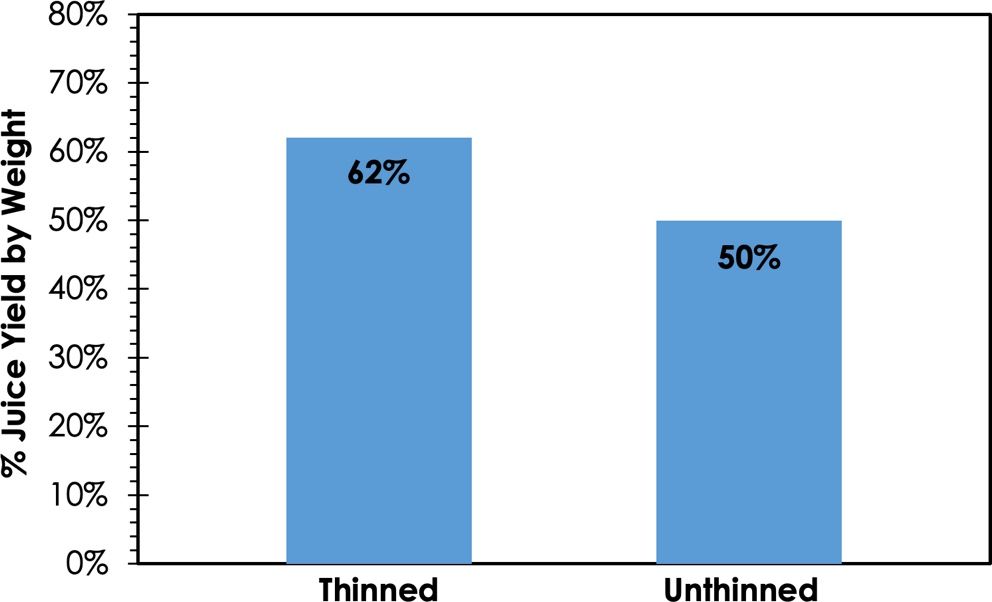
Credit: Savanna J. Curtis, former graduate student, UF/IFAS
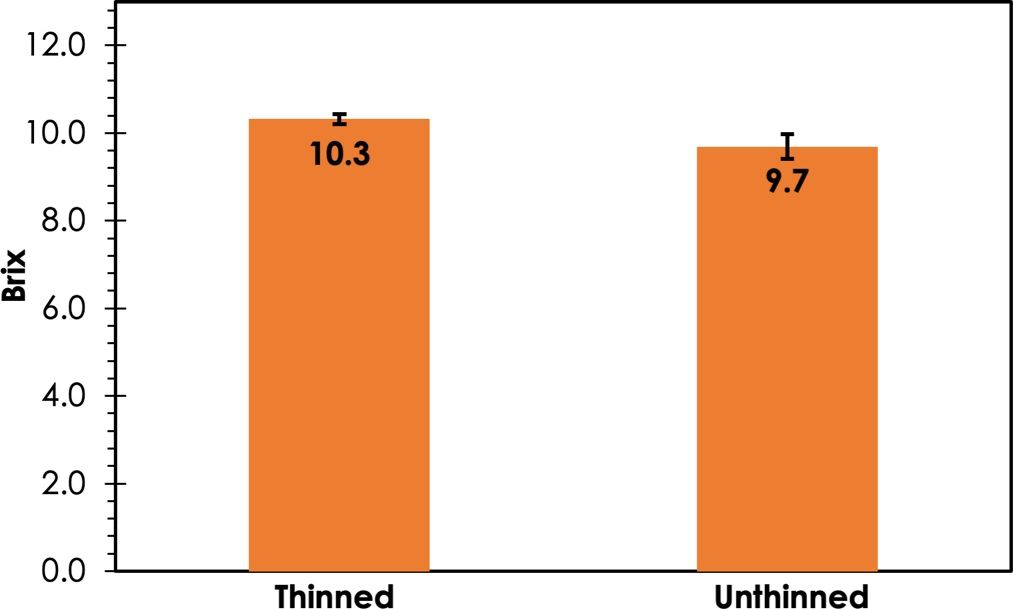
Credit: Savanna J. Curtis, former graduate student, UF/IFAS
Economic Assumptions
In order to determine the economic feasibility of processing ‘UFSun’ peaches, a simple cost analysis has been prepared based on a list of assumptions. The analysis was designed only to compare the cost and benefit of thinning trees and cannot predict total profit for peach growers. Based on assumptions, the analysis includes a rudimentary breakdown of what kinds of costs these growers can expect from processing their tree-ripened peach crop. The analysis is designed on a 1-acre basis, does not include labor costs outside of thinning trees by hand (pruning, harvesting, pest control, general field care, etc.), assumes that grading is based solely on fruit size, and does not include capital costs and utilities for processing. The theoretical cost analysis was also created on the basis that a grower has access to or owns processing equipment; it is understood that this may not be true for many facilities and the feasibility assessment is for example purposes only.
The following assumptions, based on standard known data for north Florida peach production (Ali Sarkhosh, unpublished interview, 2018) were made to support the analysis in Figure 13:
- The orchard has 145 trees.
- Thinning costs $1,500 per acre (Ferguson et al. 2008).
- Thinned trees produce 100 lb of fruit mass.
- Unthinned trees produce 200lb of fruit mass, which is two times the mass from a thinned tree.
- High-grade fruit (2 to 2.5 inches in diameter) can be sold for $1.50/lb to fresh markets (Olmstead et al. 2015).
- Low-grade fruit (less than 2 inches in diameter) will not be sold.
- For an acre of thinned trees, 70% of the harvested fruit will be an acceptable size, considered high grade, and sold to the fresh market.
- For an acre of unthinned trees, 0% of the harvested fruit will be sold to the fresh market, meaning 100% of the fruit will be unacceptable in size and therefore considered low grade.
- There is an approximate 60% yield by weight when pressing juice from thinned peaches.
- Juice has 10% sugar by weight and is 10 °Brix in sugar content (10 °Brix = 1.038kg/L in density).
- Juice will be sold for $0.80/L.
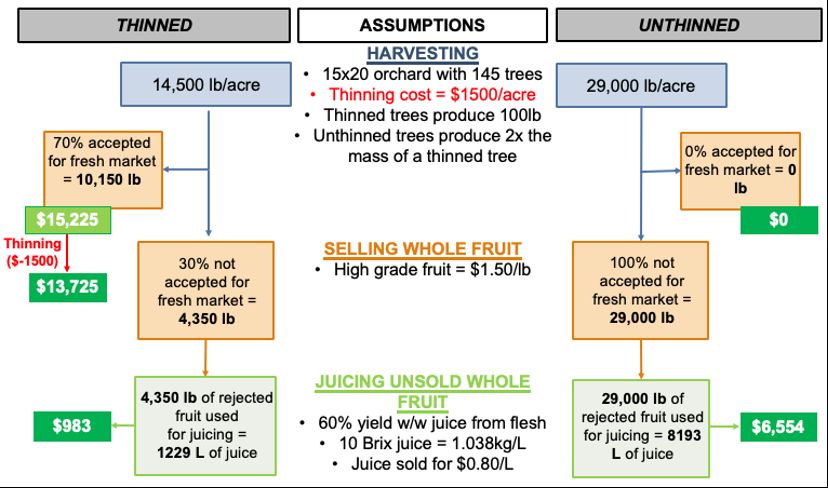
Credit: Savanna J. Curtis, former graduate student, UF/IFAS
Conclusions
Using the cost assumption of $1.50/lb for high-quality fruit and $0.80/L for peach fruit juice, as previously mentioned in the Economic Assumptions section, high-quality fruit will make a greater overall profit on a volume basis than low-quality fruit produced for juicing. Even considering the higher fruit mass yield of unthinned trees, a grower would need to sell unthinned fruit juice for ~$1.86/L in order to match the potential profit of high-quality fruit from thinned trees. Therefore, the economic benefit of thinning trees depends heavily on the price for which a juicing operation is able to sell bulk juice. However, juicing operations provide a viable alternative option for low-quality, unacceptable, and unsold fruit. Peach juice could potentially sell at premium price rates to local wine, mead, beer, kombucha, or other fermented beverage operations as an adjunct or flavoring agent. There are also possibilities to sell peach juice at farmer’s markets, as long as it was properly treated and processed according to FDA state and local regulations codes for pressed-juice beverages.
References
Abidi, W., S. Jimenez, M. A. Moreno, and Y. Gogorcena. 2011. “Evaluation of Antioxidant Compounds and Total Sugar Content in a Nectarine [Prunus persica (L.) Batsch] Progeny.” International Journal of Molecular Science 12 (10): 6919–6935. https://doi.org/10.3390/ijms12106919
Bates, R. P., J. R. Morris, and P. G. Crandall. 2001. “Tree Fruit: Apple, Pear, Peach, Plum, Apricot and Plums.” In Principles and Practices of Small- and Medium-scale Fruit Juice Processing. 150–169. Rome, Italy: Food & Agricultural Organization.
Chang, Y., A. Sarkhosh, J. Brecht, and P. Andersen. 2019. “Thinning Florida Peaches for Larger Fruit.” HS1324. Gainesville: University of Florida Institute of Food and Agricultural Sciences. https://edis.ifas.ufl.edu/hs1324
Crisosto, C. H., and G. Costa. 2008. “Preharvest Factors Affecting Peach Quality.” In The Peach: Botany, Production and Uses. Cambridge, MA: CAB International. 536–549.
Crisosto, C. H., and D. Valero. 2008. “Harvesting and Postharvest Handling of Peaches for the Fresh Market,” In The Peach: Botany, Production and Uses. Cambridge, MA: CAB International. 575–596.
Curtis, S. J. 2019. “An Assessment of the Processing, Fermentation, and Volatile Characteristics of Juice from ‘UFSun’ Peaches Grown on Thinned and Unthinned Trees.” Master's thesis, University of Florida. https://ufdc.ufl.edu/UFE0056195/00001/pdf
Ferguson, J., P. Anderson, J. Chaparro, and J. Williamson. 2008. “Florida Subtropical Peaches: General Concepts and Cultivars Recommended for Grower Trials.” HS1125. Gainesville: University of Florida Institute of Food and Agricultural Sciences. https://journals.flvc.org/edis/article/download/117220/115336/170128
Freedonia Group. 2017. Fresh Produce: U.S. Retail Market Trends and Opportunities: Market Research Report. Packaged Facts. https://www.packagedfacts.com/Fresh-Produce-Trends-Opportunities-11000277/
Iezzoni, A. 2019. “Peach Fruit Texture.” Plant Breeding and Genomics. https://plant-breeding-genomics.extension.org/peach-fruit-texture/
Jayani, R. S., S. Saxena, and R. Gupta. 2005. “Microbial Pectinolytic Enzymes: A Review.” Process Biochemistry 40 (9): 2931–2944. https://doi.org/10.1016/j.procbio.2005.03.026
Kader, A. A. 2013. “Postharvest Technology of Horticultural Crops—An Overview from Farm to Fork.” Ethiopian Journal of Applied Science and Technologies. 1–8. https://ucanr.edu/sites/Postharvest_Technology_Center_/files/231724.pdf
Lurie, S., and C. H. Crisosto. 2005. “Chilling Injury in Peach and Nectarine.” Postharvest Biology and Technology 37 (3): 195–208. https://doi.org/10.1016/j.postharvbio.2005.04.012
Oliveira, M. A., M. Pintado, and D. P. F. Almeida. 2012. “Phytochemical Composition and Antioxidant Activity of Peach as Affected by Pasteurization and Storage Duration.” LWT – Food Science and Technology 49 (2): 202–207. https://doi.org/10.1016/j.lwt.2012.07.008
Olmstead, M. A., J. L. Gilbert, T. A. Colquhoun, D. G. Clark, R. Kluson, and H. R. Moskowitz. 2015. “In Pursuit of the Perfect Peach: Consumer-assisted Selection of Peach Fruit Traits.” HortScience 50 (8): 1202–1212. https://doi.org/10.21273/HORTSCI.50.8.1202
Petruzzi, L., D. Campanello, B. Speranza, M. R. Corbo, M. Sinigaglia, and A. Bevilacqua. 2017. “Thermal Treatments for Fruit and Vegetable Juices and Beverages: A Literature Overview.” Comprehensive Reviews in Food Science and Food Safety 16 (4): 668–691. https://doi.org/10.1111/1541-4337.12270.
Rumble, J. N., K. Harders, and K. Stofer. 2021. “Florida Peaches: A Perfect Snack.” AEC625. Gainesville: University of Florida Institute for Food and Agricultural Sciences. http://edis.ifas.ufl.edu/wc287
Rumble, J. N., and C. G. Roper. 2017. “Talking Local: Florida Consumers’ Fresh from Florida Perceptions: AEC516/WC181, Rev. 11/2017.” EDIS 2017 (4). https://doi.org/10.32473/edis-wc181-2017
Sarkhosh, A., M. Olmstead, J. Chaparro, P. Anderson, and J. Williamson. 2019. “Florida Peach and Nectarine Varieties.” CIR1159. Gainesville: University of Florida Institute of Food and Agricultural Sciences. http://edis.ifas.ufl.edu/mg374
Sarkhosh, A., M. Olmstead, J. Williamson, J. Chaparro, and J. Popenoe. 2019. “Alternative Opportunities for Small Farms: Peach and Nectarine Production Review.” RFAC018. Gainesville: University of Florida Institute for Food and Agricultural Sciences. https://edis.ifas.ufl.edu/ac018
United States Food and Drug Administration (FDA). 2019. “101.30 Percentage Juice Declaration for Foods Purporting to be Beverages that Contain Fruit or Vegetable Juice.” In Code of Federal Regulations Title 21, Vol. 2: 108–110. https://www.govinfo.gov/content/pkg/CFR-2019-title21-vol2/pdf/CFR-2019-title21-vol2.pdf